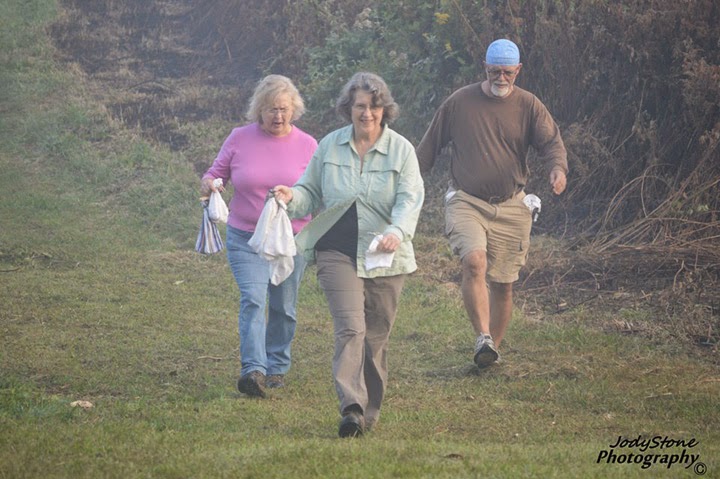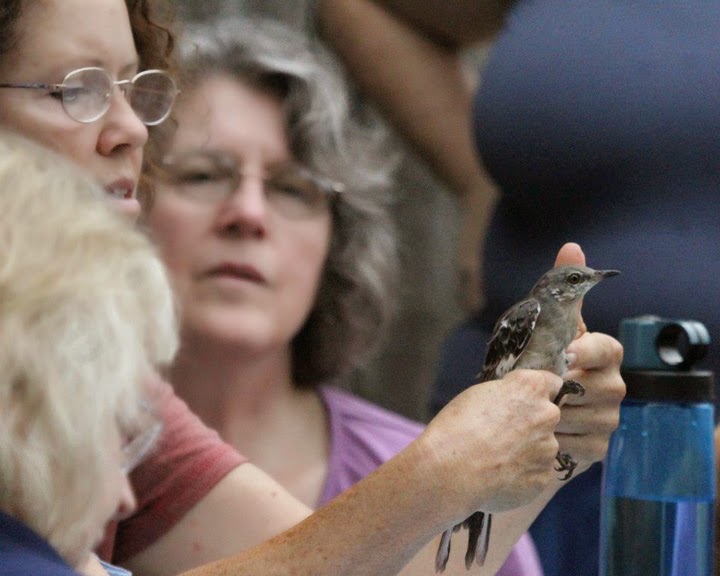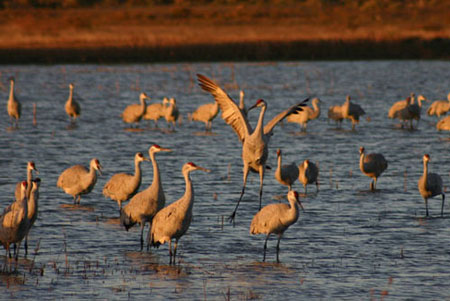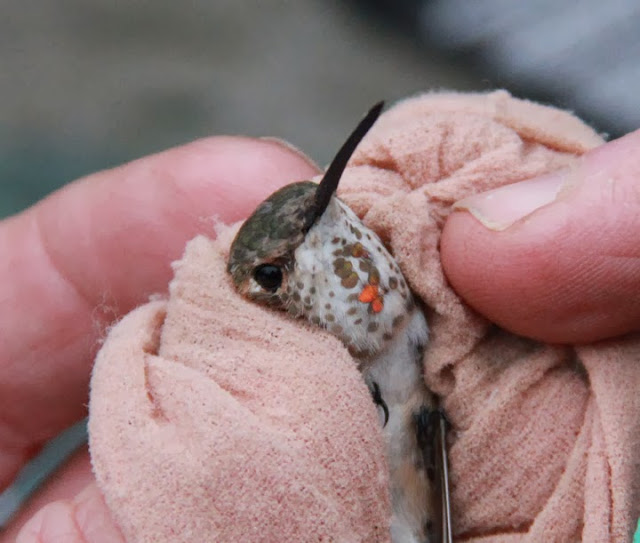Have you ever seen the aurora borealis, also known as the Northern Lights? I've had the good fortune of seeing them twice, once in Minot, North Dakota in the early 70's and in 2012 from the plane as I was flying out of Fairbanks, Alaska.
This video is an incredible and moving capture of the spectacular light display that occurred in March of 2013, filmed and narrated by Todd Salat. I think you will enjoy it as much as I did.
What are Northern Lights?
Todd Salat
My visit to Alaska 2012--begin with the oldest post to see these posts in sequence or just enjoy the images as they appear. It is a work in progress. I have many more stories and photos to post on this amazing trip.
Monday, January 20, 2014
Thursday, January 16, 2014
Hardy Hummingbirds Survive the Polar Vortex Plunge
On January 13, I accompanied Mark Armstrong to another hummingbird banding in Knoxville, Tennessee, just six days after local temperatures plunged to a record low of 2° F during the Polar Vortex.
Photo credit: Mark Armstrong
A wintering hummingbird was discovered at the home of Christal Pettit early in October. Soon after she had taken her feeders down thinking all the migrating Ruby-throats had left, her husband noticed a hummingbird hovering in an area where a feeder once hung. Krystal quickly made nectar and hung a feeder out and her wintering hummingbird has been steadily present since.
Christal (left) and her daughter, Evan, watch as Mark Armstrong, Master Bander of hummingbirds bands the hummingbird and measures its wing, tail, and beak. Each of these measurements give the bander information about the gender and species of the hummingbird, in this case, a mature female Rufous.
Mature females look alike in the three Selasphorus species which include the Broad-tailed, Rufous and Allen's hummingbirds. They each have green feathered backs and, usually, a cluster of reddish-orange gorget feathers on their throats. The Rufous species is by far the most commonly found wintering hummingbird in Tennessee and in the eastern United States.
Mark uses a straw and blows the feathers away from the belly to assess the amount of fat the hummingbird has stored. This hummingbird's fat was rated a "one" with zero indicating no fat deposits, and she weighed 3.9 grams, a healthy weight for this species. This means she is receiving enough nutrition to not only nourish herself, but to store fat reserves for later use.
Additionally, this mature female was molting feathers--losing worn feathers and growing new ones to replace them. In the image above, you can see the three brownish old feathers with frayed ends on the left compared to her new grayish feathers with smooth edges. She was also showing new feather growth on her body and head. Molting, in general, is a sign of good health and nutrition and Mark commented that this bird was molting more heavily than he had seen in other hummers he's captured this season.
Photo credit: Mark Armstrong
Above you can see the Rufous female tail feathers compared to the male's tail feathers shown in my previous post. Females have white tips on their three outer tail feathers on each side. The white tips lack pigment, which adds strength to feathers, and are worn more easily during the process of nest building and feeding young during the breeding season.
Above, Mark and Christal give the hummingbird a drink before she is released.
It is a joy to meet the people who host these wintering hummers and to share in their excitement about their visitors. To date, Mark has banded nine Rufous hummingbirds in east Tennessee and recaptured four--three that he previously banded, and one bird that was banded in Tallahassee, FL last year as a juvenile. Recapturing a bird after it is banded enables researchers to learn more about the age, health and migration patterns of the hummingbirds that are migrating east for the winter.
Photo credit: Billie Cantwell
Other reports on area hummingbirds varied after the severe weather front moved through. Billie Cantwell and Colin Leonard's male hummingbird, that first began wintering at their home in 2011, continues to frequent their feeder. The above image, taken several days after the severe weather, shows the light arrangement that Billie and Colin hung over the feeder to keep the nectar from freezing. The light is a 150 watt flood light or spot light that is non-LED and gives off heat. When temperatures were in the single digit range, Billie moved the feeder closer to the lamp; when the temperature moves up to 17 F or higher, the feeder is hung farther away.
Photo credit: Jon Dempersmier
Above, another female hummingbird continues to winter in Seymour, Tennessee, and was photographed at the feeder by Jon Dempersmier January 8th, the day after the record cold. Though Mark has not recaptured this bird, yet, she wears a band and is likely the Rufous female that he banded at Jon's home last season.
Photo credit: Katheryn Noblet
The adult female Rufous, above, that made a fall migration stop-over at Katherine Noblet's home in Johnson City, departed prior to the severe weather and was last seen on December 4th.
Photo credit: Marnie Mitchell
The mature male Rufous pictured above has been wintering in Smithville, TN, at the home of Tommy and Virginia Curtis, and was seen frequenting the feeders following the severe front. He departed on January 9th, likely, to resume migration.
Photo credit: Wally Manspeaker
The image above was taken on January 6th, in Russellville, TN, as the artic air was approaching with high winds that rocked the feeder and brought windchills of -14 degrees F in east Tennessee. Wally's female Rufous was among the several that were not seen on January 7th, the morning of the lowest temperature drop. Included in this group were Sherry Ladd's mature male Rufous, Candy Casey's adult female Rufous, and Jim Turnblazer's juvenile female Rufous.
Candy Casey wrote a letter to Bob Sargent on January 7, asking about the disappearance of her bird, fearing that the female Rufous had perished in the cold as the front moved in. His response was interesting and reassuring.
"Twenty-five years of banding records tell me that most ADULT Rufous, male or female, tend to leave their primary winter site(s)...between December 15 and January 15. If they leave earlier than that, it is...in my opinion, because their easy supply of tiny bugs and spiders has been diminished. This occurs often when winter deepens.... I would bet the farm that your little cold-hardy female Rufous has gone south and then will turn westward toward her nesting grounds in Washington, Oregon, British Columbia or maybe even SE Alaska. Don't take your feeder down just in case she's hanging out somewhere close, In my opinion she is not likely to be dead but merely moved on to the south or southwest."
Many of us will be watching for the return of these birds next fall and looking forward to re-capture reports that will affirm their survival and successful migration. It is clear that this hardy strain of eastern-migrating Rufous hummingbirds is challenging our notion of hummingbird frailty and raising many questions about their winter survival strategies.
Links and Resources:
What is a Polar Vortex?
Climate Change and the Polar Vortex
Western Hummingbirds Wintering in Tennessee
Allen's Hummingbird in Tennessee
Rufous Hummer in Knoxville
Other blog posts on Wintering hummingbirds in Tennessee
In recent years, fourteen species of hummingbirds have been documented in the east during fall and winter months. Visit Bob Sargent's information on wintering hummingbirds
Bob Sargent describes the Rufous Hummingbird as very cold-hardy.
Sargent on wintering Calliopes and the Allen's Hummingbird
Hummingbird banding
Hummingbirds in watercolor
Hummingbird art on Vickie's Sketchbook blog
Cornell's All About Birds: Rufous Hummingbirds
Bird Banding Laboratory
Birds of North America--I highly recommend subscribing to the online version for detailed descriptions of all North American bird species.
Photo credit: Mark Armstrong
A wintering hummingbird was discovered at the home of Christal Pettit early in October. Soon after she had taken her feeders down thinking all the migrating Ruby-throats had left, her husband noticed a hummingbird hovering in an area where a feeder once hung. Krystal quickly made nectar and hung a feeder out and her wintering hummingbird has been steadily present since.
Christal (left) and her daughter, Evan, watch as Mark Armstrong, Master Bander of hummingbirds bands the hummingbird and measures its wing, tail, and beak. Each of these measurements give the bander information about the gender and species of the hummingbird, in this case, a mature female Rufous.
Mature females look alike in the three Selasphorus species which include the Broad-tailed, Rufous and Allen's hummingbirds. They each have green feathered backs and, usually, a cluster of reddish-orange gorget feathers on their throats. The Rufous species is by far the most commonly found wintering hummingbird in Tennessee and in the eastern United States.
Mark uses a straw and blows the feathers away from the belly to assess the amount of fat the hummingbird has stored. This hummingbird's fat was rated a "one" with zero indicating no fat deposits, and she weighed 3.9 grams, a healthy weight for this species. This means she is receiving enough nutrition to not only nourish herself, but to store fat reserves for later use.
Photo credit: Mark Armstrong
Above, Mark and Christal give the hummingbird a drink before she is released.
It is a joy to meet the people who host these wintering hummers and to share in their excitement about their visitors. To date, Mark has banded nine Rufous hummingbirds in east Tennessee and recaptured four--three that he previously banded, and one bird that was banded in Tallahassee, FL last year as a juvenile. Recapturing a bird after it is banded enables researchers to learn more about the age, health and migration patterns of the hummingbirds that are migrating east for the winter.
Photo credit: Billie Cantwell
Other reports on area hummingbirds varied after the severe weather front moved through. Billie Cantwell and Colin Leonard's male hummingbird, that first began wintering at their home in 2011, continues to frequent their feeder. The above image, taken several days after the severe weather, shows the light arrangement that Billie and Colin hung over the feeder to keep the nectar from freezing. The light is a 150 watt flood light or spot light that is non-LED and gives off heat. When temperatures were in the single digit range, Billie moved the feeder closer to the lamp; when the temperature moves up to 17 F or higher, the feeder is hung farther away.
Photo credit: Jon Dempersmier
Above, another female hummingbird continues to winter in Seymour, Tennessee, and was photographed at the feeder by Jon Dempersmier January 8th, the day after the record cold. Though Mark has not recaptured this bird, yet, she wears a band and is likely the Rufous female that he banded at Jon's home last season.
Photo credit: Katheryn Noblet
The adult female Rufous, above, that made a fall migration stop-over at Katherine Noblet's home in Johnson City, departed prior to the severe weather and was last seen on December 4th.
Photo credit: Marnie Mitchell
The mature male Rufous pictured above has been wintering in Smithville, TN, at the home of Tommy and Virginia Curtis, and was seen frequenting the feeders following the severe front. He departed on January 9th, likely, to resume migration.
Photo credit: Wally Manspeaker
The image above was taken on January 6th, in Russellville, TN, as the artic air was approaching with high winds that rocked the feeder and brought windchills of -14 degrees F in east Tennessee. Wally's female Rufous was among the several that were not seen on January 7th, the morning of the lowest temperature drop. Included in this group were Sherry Ladd's mature male Rufous, Candy Casey's adult female Rufous, and Jim Turnblazer's juvenile female Rufous.
Candy Casey wrote a letter to Bob Sargent on January 7, asking about the disappearance of her bird, fearing that the female Rufous had perished in the cold as the front moved in. His response was interesting and reassuring.
"Twenty-five years of banding records tell me that most ADULT Rufous, male or female, tend to leave their primary winter site(s)...between December 15 and January 15. If they leave earlier than that, it is...in my opinion, because their easy supply of tiny bugs and spiders has been diminished. This occurs often when winter deepens.... I would bet the farm that your little cold-hardy female Rufous has gone south and then will turn westward toward her nesting grounds in Washington, Oregon, British Columbia or maybe even SE Alaska. Don't take your feeder down just in case she's hanging out somewhere close, In my opinion she is not likely to be dead but merely moved on to the south or southwest."
Many of us will be watching for the return of these birds next fall and looking forward to re-capture reports that will affirm their survival and successful migration. It is clear that this hardy strain of eastern-migrating Rufous hummingbirds is challenging our notion of hummingbird frailty and raising many questions about their winter survival strategies.
In east Tennessee, report winter hummingbird sightings to Mark Armstrong at Woodthrush@bellsouth.net or 865-748-2224. For a list of contact information for other eastern areas, visit winter reporting on the Hummer Study Group website or report sightings to Bob and Martha Sargent, Rubythroat@aol.com or 205-681-2888.
What is a Polar Vortex?
Climate Change and the Polar Vortex
Western Hummingbirds Wintering in Tennessee
Allen's Hummingbird in Tennessee
Rufous Hummer in Knoxville
Other blog posts on Wintering hummingbirds in Tennessee
In recent years, fourteen species of hummingbirds have been documented in the east during fall and winter months. Visit Bob Sargent's information on wintering hummingbirds
Bob Sargent describes the Rufous Hummingbird as very cold-hardy.
Sargent on wintering Calliopes and the Allen's Hummingbird
Hummingbird banding
Hummingbirds in watercolor
Hummingbird art on Vickie's Sketchbook blog
Cornell's All About Birds: Rufous Hummingbirds
Bird Banding Laboratory
Birds of North America--I highly recommend subscribing to the online version for detailed descriptions of all North American bird species.
Monday, January 6, 2014
Male Rufous Hummingbird in Knoxville, Tennessee
It is nothing short of amazing to consider Rufous Hummingbirds wintering in Tennessee right now with a frigid artic front pushing our temperatures down to 0° degrees F and creating wind chills approaching 10 below zero.
Photo credit: Mark ArmstrongThis beautiful Rufous male shown above was captured and banded in Knoxville, Tennessee, by Mark Armstrong on Sunday, January 5th, at the home of Sherry Ladd. Mark was assisted by myself and Billie Cantwell (below), president of the Knoxville Chapter of the Tennessee Ornithological Society. Billie also has a mature male Rufous wintering at her home in Knoxville for the third winter.
Mark reported that this mature male was only the third he had seen this season, though he has banded a number of Rufous hummingbirds in the past several months. The other birds have been mature or juvenile females or juvenile males. In the image above, Billie explains how Mark captures the hummingbird as he sets up the trap and secures the feeder inside it.
The hummer was captured quickly and carefully removed from the trap and placed in a soft net bag. Below, Mark organizes his equipment while Sherry holds the hummingbird briefly and I record the date and time on the data sheet. The temperature was in the low-thirties during this banding visit, which fortunately took place before the record breaking artic air moved into our area.
Photo credit: Billie Cantwell
Below, Mark measures the length of the wing with a digital instrument. He also measures the length of the tail and examines the beak for grooving.
Photo credit: Billie Cantwell
These details and measurements give specific information about the individual bird, help confirm the species and gender, and give clues to the bird's health. Both this mature male and the mature male wintering at Billie's home were found to be of the same weight, a normal weight for a male rufous. Mature males have the characteristic rufous tail, shown below, lacking the white tips of a juvenile.
Photo credit: Mark ArmstrongBob Sargent, who has studied the eastern migration of Rufous hummingbirds since the late 90's has the following to say about the Rufous species: "Rufous hummingbirds are very cold hardy. They are hatched in a cold climate, they spend nights on nesting grounds where the temperatures are near freezing. They migrate down mountain corridors where the temperatures are cold. Finally, these U.S. Rufous are continually being refined by the genes of cold hardy ancestors that have endured severe winters. We regularly have Rufous in the Southeast that seem little effected by nighttime temperatures of 0 to 20 degrees F. The presence of Rufous going about their daily routine in times of severe cold requires rethinking our impression of hummingbirds in general."
Above, Mark offers the bird a drink from the feeder before he is released. Once he was released into Sherry's hand, he buzzed away immediately.
Photo credit: Mark Armstrong
In east Tennessee, report winter hummingbird sightings to Mark Armstrong at Woodthrush@bellsouth.net or 865-748-2224. For a list of contact information for other eastern areas, visit winter reporting on the Hummer Study Group website or report sightings to Bob and Martha Sargent, Rubythroat@aol.com or 205-681-2888.
Next: Winter birds and an update on Tennessee's hummingbirds during the extreme cold.
Western Hummingbirds Wintering in Tennessee
Allen's Hummingbird in Tennessee
Rufous Hummer in Knoxville
Other blog posts on Wintering hummingbirds in Tennessee
In recent years, fourteen species of hummingbirds have been documented in the east during fall and winter months. Visit Bob Sargent's information on wintering hummingbirds
Bob Sargent describes the Rufous Hummingbird as very cold-hardy.
Sargent on wintering Calliopes and the Allen's Hummingbird
Hummingbird banding
Hummingbirds in watercolor
Hummingbird art on Vickie's Sketchbook blog
Cornell's All About Birds: Rufous Hummingbirds
Bird Banding Laboratory
Birds of North America--I highly recommend subscribing to the online version for detailed descriptions of all North American bird species.
Saturday, January 4, 2014
Tennessee Conservationist Magazine--Tennessee Students Discover Birds
The January/February issue of the Tennessee Conservationist Magazine has just been delivered to the hands of subscribers and it includes my article on the Discover Birds Program, an innovative program that introduces students to the fascinating world of birds.
Inspired by the Discover Birds Activity Book, and prompted by a desire to provide young people with a memorable introduction to birds, a team of volunteers from the Knoxville Chapter of the Tennessee Ornithological Association visits area schools, donating books to all of the classrooms of a single grade level, and takes the students and their teachers through a three-part birding program. The students are divided into smaller groups and on a rotating schedule, they experience a slide show presentation of Tennessee birds and their songs and a show-and-tell treasure chest of bird related items, such as, talons, feathers and nests. They also learn to identify birds in their schoolyard through guided bird walks with a close-up view of birds through birding telescopes.As the writer and illustrator of the Discover Birds Activity Book, I am delighted with the program and the excitement I see when children and teachers are introduced to birds in this memorable way.
The Discover Birds Activity Book includes science, math and language activities contributed by a team of educators including members of the National Intitute of Mathematical and Biological Synthesis, the Great Smoky Mountains Institute at Tremont, and individual naturalists and educators. Using actual data from the Geological Survey's annual Breeding Bird Surveys, students learn to graph bird population fluctuations and consider what may be influencing these changes. Another activity includes a fun decoding math formula to learn which birds are the champions of speed, distance and size. In other activities, students are introduced to the interesting traits that make birds unique members of the wildlife community and among the most fascinating to observe and study.
A special "thank you" goes to editor, Louise Zepp, for including this article in her award winning magazine published by the Tennessee Department of Environment and Conservation . The issue is available for $3.25 and can be ordered at The Tennessee Conservationist Magazine website.
Visit the Discover Birds Blog to see more about the Discover Birds Program activities. Visit the Tennessee Ornithological Society's education page to find more information about the program and the Discover Birds Activity Book, including an online version of the book.
For more information about the Discover Birds Program, contact Billie Cantwell at bfcantwell@gmail.com or Cyndi Routledge at routledges@bellsouth.net. For information about obtaining printed books, contact Cyndi Routledge at routledges@bellsouth.net.
Subscribe to:
Posts (Atom)
Ocean Trail at Palos Verdes Nature Preserve, California--2015

Bird-banding at Seven Islands State Birding Park--2014

Photo courtesy of Jody Stone
Bird-banding at Seven Islands

Photo courtesy of Karen Wilkenson
Enjoying Gray Jays in Churchill!--2014

Photo courtesy of Blue Sky Expeditions
Smithsonian National Zoo with one of my Whooping Crane banners and son, John--2014

The Incredible Muir Woods near Stinson Beach, CA--2014

Photo courtesy of Wendy Pitts Reeves
Me and Denali--2012

Photo courtesy of Bob King
For the Love of It...
...the sage sees heaven reflected in Nature as in a mirror, and he pursues this Art, not for the sake of gold or silver, but for the love of the knowledge which it reveals.
Sendivogius (1750)
Sendivogius (1750)
Your Uncapped Creativity...

"There is a vitality, a life force, an energy, a quickening that is translated through you into action; and because there is only one of you in all time, this expression is unique. If you block it, it will never exist through any other medium and it will be lost. The world will not have it. You must keep that channel open. It is not for you to determine how good it is, nor how valuable. Nor how it compares with other expressions. It is for you to keep it yours, clearly and directly." ----the great dancer, Martha Graham




























